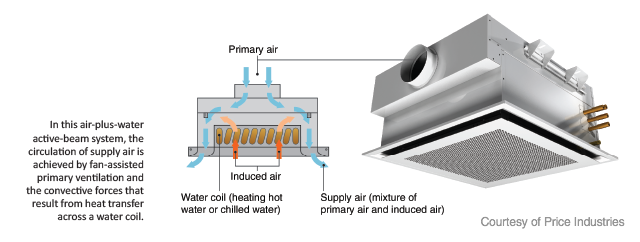Consider These Passive Or Energy-Efficient Active HVAC Systems
Once heat gain is reduced, passive HVAC systems or more energy-efficient active systems can be installed to satisfy occupant comfort.
Passive systems are effective in net-zero buildings because they allow the user to maintain comfort in a space without the need for energy. Common passive techniques include natural ventilation and the use of thermal mass.
Natural ventilation relies on outdoor air and appropriate high/low window placement to ventilate, bring in fresh air, and relieve hot air. Exposed thermal mass can often be provided in the form of concrete, water, or other materials to evenly regulate surface temperatures, even when exposed to heat. Exposed thermal mass is often used in conjunction with natural ventilation in order to pre-cool surfaces at night and store this coolth for daytime use.
Passive systems have two limitations: They can be slow to respond to changes in load, and they can have limited capacity. This makes the load-reduction strategies even more important. In mixed-mode buildings, passive systems are supplemented by active HVAC systems to operate during periods when outdoor temperatures are high or low.
Energy-Efficient Active Systems
When it comes to active-system design strategies, it's important to remember that any measures that can help occupants maintain comfort without turning on building HVAC systems should be considered. Local personal workstation cooling systems or high-volume, low-velocity ceiling fans may allow facility staff to increase building temperature set-points while maintaining comfort. The premise of "adaptive comfort" is that people can accept a wider range of temperature if they have the means to make adaptive, local adjustments such as altering air velocity, modifying clothing levels, or changing the activity schedule.
For heating applications on small- to mid-sized commercial net-zero projects, electric heat pumps are often the preferred means for generating heat. The reason is that they can take advantage of electricity from on site renewable sources (e.g., from photovoltaics or wind turbines); that's why net-zero projects use natural gas heating systems less often than other types of projects. Other sources of heat, such as solar thermal collectors, are common ways to offset the electrical heating requirements.
Radiant systems, such as chilled or heated floors and ceilings, are effective for net-zero applications both in heating and cooling. These systems temper the environment without needing a fan to circulate air. Air-plus-water systems, such as active chilled beams, can also offset fan energy. A pump is required to circulate water; however, water is a much more efficient medium for transferring heat or cold than air.
For applications requiring large quantities of air, either due to ventilation or cooling demand, a means to offset fan energy should be considered.
The conventional method for doing this is to reduce supply air volume during temperate periods using a variable air volume (VAV) system. A VAV system uses a variable frequency drive in conjunction with the fan to modulate speed. Because fan power depends on airflow and static pressure, some systems look to save energy by reducing static pressure. An underfloor air distribution (UFAD) system can accomplish this goal by moving low-velocity air through a raised floor cavity to reduce the length of high-velocity air ducts. A UFAD system also supplies air at a higher temperature than VAV systems and often uses outside air to provide free cooling, leading to greater efficiency.
For larger applications, central plants employ water-cooled chillers with heat rejection from cooling towers. For this size of net-zero project, efficiency would be the driver for all mechanical components. There are opportunities, however, to use natural energy sources such as geothermal heating/cooling to modulate temperature in the HVAC fluids.



Related Topics:
















